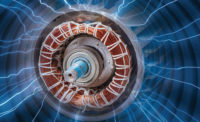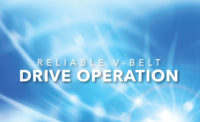A new edition of the only American National Standard for electric motor and generator repair was published in late 2010 by the Electrical Apparatus Service Association (EASA). ANSI/EASA AR100-2010: Recommended Practice for the Repair of Rotating Electrical Apparatus (AR100) specifies and details good practices for repair, rewinding, and testing that enable apparatus rebuilders to maintain or improve the energy efficiency and reliability of AC and DC motors and generators. This article discusses the mechanical aspects of motor repair that AR100 prescribes, as well as their importance for endusers. Topics include cleaning, lubrication, bearings, and repair of frames, shafts, and bearing fits.
For endusers, one value of AR100 (Figure 1) is that in just 22 pages, it concisely describes “good repair practices.” It also provides six pages of supplemental information. Further, endusers who require service centers to comply with the recommended practices in AR100 can be ensured that repairs will be made in accordance with a recognized American National Standard. The expected result will be a “good practice repair” — i.e., a quality repair without shortcuts.
GENERAL SECTION
The stated purpose of AR100 appears in the “General” section: “to establish guidelines in each step of electrical apparatus rewinding and rebuilding.” To accomplish this, the document provides practical guidance on all aspects of rotating electrical apparatus repair, especially those that apply to motors and generators.
Regarding the scope of the document, the General section says it “describes record keeping, tests, analysis, and general guidelines for the repair of electrical motors and generators,” i.e., details pertaining to repair records, testing, and repair procedures. The terms “electrical motors and generators” are used here without qualification, which means AR100 applies to all alternating current (AC) and direct current (DC) machines.
The General section also recommends identification practices for service center labeling, recordkeeping, and original and replacement nameplates. Labeling includes identifying the service center and repair order number. The repair record should contain key information such as nameplate data; electrical, mechanical test, and inspection data; and winding data.
To conform with AR100, the repair record should also identify the primary cause of failure. Diagnosing and correcting the problem during the repair helps prevent a recurrence and increases the reliability of the motor. For the enduser, the documentation can facilitate troubleshooting in the event of a problem with the motor installation. It is also a useful reference for the service center, should the motor fail again.
The General section recommends cleaning all windings and parts but avoids delving into cleaning methods (Figure 2). Although this requirement seems obvious, the document would be remiss had it not addressed the subject.
Other recommendations in this section cover terminal leads, terminal connectors, and terminal boxes; the cooling system; the exterior finish; and packaging and transportation.
The final paragraphs in the General section recommend inspecting the cooling system (including fans, cooling ducts, air baffles, and cover plates) to confirm that it is clean and operational (Figure 3). Many standards and specifications focus solely on testing. By recognizing that good practice inspections lead to corrective actions, AR100 goes beyond this, providing added value to service centers and endusers.
The document also recommends that the exterior finish be cleaned and painted, and that the shaft extensions be protected against corrosion. Although these may be subtle points, they provide another indication that a good practice repair has been performed.
Another recommendation is to pack the motor appropriately for the mode of transportation and the distance to be traveled. This may include blocking the shaft, identifying the presence of shaft blocking, shipping oil-lubricated machines without oil, and identifying the need for oil-lubricant.
MECHANICAL REPAIR SECTION
The Mechanical Repair section covers the major mechanical components of the machine such as shafts, bearings, frames, bearing housings, and laminations. The text here is generously supplemented with 14 tables that provide many important dimensions and tolerances (Table 1).
For motor and generator rebuilders, a distinct advantage of AR100 is having these tables in one readily available place, rather than needing to find them in individual source documents from the American Bearing Manufacturers Association (ABMA), International Electrotechnical Commission (IEC), and National Electrical Manufacturers Association (NEMA). Anyone who has tried to locate specific statements in NEMA MG 1: Motors and Generators will undoubtedly appreciate the presence of these tables in AR100.
The Mechanical Repair section stipulates that shafts and shaft extensions be checked for wear, cracks, scoring, and straightness. To that end, the tolerances for diameters, runout, and keyways are based on NEMA and IEC standards. The supporting text also provides guidance to help service centers achieve reliable repairs, e.g., that keyseats (keyways) should accommodate keys to a tap fit. Dimensional conformity is critical to ensure a proper fit when endusers install attachments such as couplings on the output shaft.
This section also addresses ball and cylindrical roller bearings, for which it provides two comprehensive tables of specific housing and journal fits and tolerances. Of all the tables in AR100, service centers probably refer to these two the most, because proper fits significantly increase the potential for obtaining full rated bearing life.
Additionally, the Mechanical Repair section includes guidance on sleeve bearing fits, end thrust, oil rings, and seals. It also covers topics that other standards seldom address, such as labyrinth seal clearances, providing a table for shaft diameters of 3.000 to 7.500 in. (76 to 191 mm). These values illustrate another subtle point about AR100, that although dimensions are primarily in English units (e.g., in.), metric equivalents are also provided. That makes AR100 more user-friendly for those accustomed to metric dimensions, particularly those outside the U.S.
On the topic of lubrication, practical recommendations in the Mechanical Repair section include checking grease passages to make sure they are clean, using grease that is compatible with the customer’s lubricant, and filling the grease reservoir to about one-third of capacity if the machine manufacturer’s instructions are not known.
Verifying grease compatibility is important (Figure 4). For example, service centers often use polyurea-based greases, which usually are not compatible with lithium-based greases that many endusers use. Confirming the use of a compatible lubricant as AR100 recommends can prevent a premature bearing failure.
The point about grease fill is critical not only to bearing and motor life but also to the energy efficiency of the motor. Over lubrication can cause ball or roller “skidding” that increases friction; it also can churn the grease, resulting in higher temperature and increased losses (i.e., reduced efficiency). The ultimate consequence could be premature and potentially catastrophic bearing failure.
Touching on other aspects of rotating electrical machines, the Mechanical Repair section recommends inspecting the frame and bearing housings for cracks and breaks. This is another example of how AR100 goes beyond tests and measurements, providing guidance for more reliable repairs that will result in greater uptime for endusers. This section also provides three tables to use in verifying that face and flange mounting surface tolerances, eccentricity, and runout comply with NEMA and IEC standards. Verification of these tolerances helps protect machines from excessive mechanical stress due to face or flange distortion.
AR100 also covers mechanical considerations for stator and rotor laminations (cores). For instance, it recommends checking the fits of the stator laminations to the frame and of the rotor core to the shaft, as well as the concentricity and runout of the laminated cores. Proper lamination fits extend bearing mechanical life by preventing vibration from such causes as eccentricity or looseness. They also prevent heating issues caused by poor physical contact between the core and frame or shaft, which could shorten the thermal life of windings, bearings, and lubricants. Avoiding negative outcomes by following the recommended practices in AR100 results in more reliable repairs for endusers.
Dynamic balance of the rotor is essential to the proper operation of a machine. In the absence of a customer specified level, AR100 suggests balancing to the international standard (ISO) quality grade 2.5 to ensure vibration levels well within NEMA and IEC standard values. A cautionary note also recommends making certain that balance weights do not interfere with other components. Low vibration levels extend bearing life; and adequate clearance between balance weights and other components helps avoid a rapid, possibly immediate, failure.
The Mechanical Repair section closes with the recommendation that accessories be tested and verified as applicable. Another example of the guidance in AR100 is that replacement bearing temperature sensors or protectors should be identical to the originals or have the same electrical and thermal characteristics. That is concise but extremely important advice. Replacing a thermistor sensor with a thermocouple device would result in an incorrect temperature indication (if any) that could cause a bearing (or winding) failure. It might also damage or destroy the temperature sensing control circuitry external to the motor.
TESTING SECTION
Following the good practice procedures in AR100 builds quality into each repair. For example, the document devotes an entire section to inspecting and testing repaired machines —often prescribing multiple tests to verify the suitability of a machine to perform in accordance with its nameplate ratings. The mechanical tests include checking the exact operating speed and measuring vibration levels at no load, and with load if applicable.
The section on testing concludes with another good practice: instrument calibration. AR100 stresses the importance of having instruments calibrated to a national standard at least annually, and of clearly labeling them with the calibration vendor’s name and calibration date. This procedure benefits endusers by avoiding such issues as a bearing failure due to a shaft journal or housing fit that is either too tight or too loose.
CONCLUSION
Although this article focuses on the mechanical aspects of electric motor repair, the ANSI/EASA AR100-2010: Recommended Practice for the Repair of Rotating Electrical Apparatus Standard also provides extensive good practices for electrical repair and rewinding of rotating electrical apparatus. By specifying that apparatus rebuilders follow the procedures in AR100, end users can be ensured of receiving quality repairs that are made in accordance with a recognized American National Standard. This standard is available as a free download at www.easa.com/energy. ES








